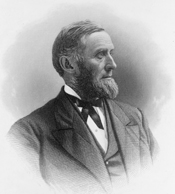Charles E. Coffin
Charles E. Coffin | |
|---|---|
 | |
| Member of the U.S. House of Representatives from Maryland's 5th district | |
| In office November 6, 1894 – March 3, 1897 | |
| Preceded by | Barnes Compton |
| Succeeded by | Sydney Emanuel Mudd I |
| Member of the Maryland Senate | |
| In office 1890–1894 | |
| Member of the Maryland House of Delegates | |
| In office 1884–1886 | |
| Personal details | |
| Born | Charles Edward Coffin July 18, 1841 Boston, Massachusetts, U.S. |
| Died | May 24, 1912 (aged 70) Muirkirk, Maryland, U.S. |
| Resting place | St. John's Episcopal Church Cemetery |
| Political party | Republican |
| Spouse | Mary Kate |
| Children | 7 |
Charles Edward Coffin (July 18, 1841 – May 24, 1912), was an American industrialist and Republican politician who moved to Maryland during the American Civil War to operate ironworks near the national capital, and later served in both houses of the Maryland legislature as well as the United States House of Representatives.[1]
Early life and education
Charles Edward Coffin was born on July 18, 1841 in Boston, Massachusetts,[2][3] descended from numerous long-settled elite New England families. He attended the Boston grammar and high schools.[2]
In 1863, he relocated to Maryland and settled at Muikirk, where he purchased a tract of land.[2] He discovered iron ore in the property and established iron works for its development.[2]
Career
In 1863, during the American Civil War, federal authorities hired Coffin's ironworks in Muirkirk, Prince George's County, Maryland to ensure they did not fall into Confederate hands. The Muirkirk Foundry Company manufactured pig iron and later upgraded to blast furnaces. Despite his legislative service described below, Coffin served as its president until his death.[1] After the war many of its laborers were freedmen, who founded an independent black community sometimes known as Rossville (or "Swampoodle"), with its historic black Queen's Chapel and Burial Ground established in 1868.
Coffin first won election to the Maryland House of Delegates in 1884 and served until 1886. In 1890 he won election to the Maryland State Senate, and served from 1890 to 1894. He was a state delegate to the Republican National Convention in 1892.
In 1894, voters from Maryland's 5th congressional district elected Coffin as a Republican to the Fifty-third Congress to fill the vacancy caused by the resignation of Democrat Barnes Compton.[1] He was re-elected to the Fifty-fourth Congress and served from November 6, 1894, to March 3, 1897.
Personal life
He was married to Mary Kate.[4] Together, they had one son and six daughters.[4]
Death
Coffin suffered a stroke in his final years and died in Muirkirk on May 24, 1912.[1] He was interred in St. John's Episcopal Church Cemetery in Beltsville, Maryland.[1]
References
- ^ a b c d e "Charles E. Coffin Dead". The Baltimore Sun. May 26, 1912. p. 3. Retrieved April 7, 2021 – via Newspapers.com.
- ^ a b c d Senate documents, Volume 7: Official Congressional Directory (1st ed.). Washington, D.C.: Government Printing Office. 1896. p. 60.
- ^ Herringshaw's American Blue Book of Biography: Prominent Americans of 1914. American Publishers' Association. 1914. p. 223. Retrieved May 31, 2024 – via Archive.org.

- ^ a b "Paralysis Ends Life of Charles E. Coffin". Evening Sun. Baltimore, MD. May 25, 1912. p. 14. Retrieved April 7, 2021 – via Newspapers.com.
External links
- United States Congress. "Charles E. Coffin (id: C000588)". Biographical Directory of the United States Congress.
- "House of Delegates, Prince George's County (1790–1966)". Archives of Maryland, Historical List. Maryland State Archives. Retrieved June 6, 2007. [dead link]
